Study on Physical Properties of Mortar for Section Restoration Using Calcium Nitrite and CO2 Nano-Bubble Water
Abstract
:1. Introduction
2. Materials and Methods
2.1. Experimental Plan
2.2. Materials and CO2 Nanobubble Water
2.2.1. Materials
2.2.2. Equipment and Process to Generate CO2 Nanobubble Water
2.3. Experimental Parameters
2.3.1. Flow
2.3.2. Compressive and Flexural Strength
2.3.3. Length Change Rate
2.3.4. Carbonation Depth
2.3.5. Porosity and SEM Analysis
3. Results and Discussion
3.1. Flow
3.2. Compressive and Flexural Strength
3.3. Length Change Rate
3.4. Carbonation Depth
3.5. Porosity
3.6. SEM
4. Conclusions
- The flow values of the specimens with calcium nitrite tended to be high. No special tendency according to the type of mixing water and the calcium nitrite content was seen. When 5% calcium nitrite was added, the length change rate sharply decreased.
- As the calcium nitrite content increased, strength and durability also increased. In particular, the use of CO2 nanobubble water effectively increased the strength and reduced the carbonation depth and porosity.
- As the calcium nitrite content increased, the generation rate and generated amount of nitrite-based hydration products increased owing to the rapid reaction between the NO2− ions in calcium nitrite and the C3A(Al2O3) in cement.
- A large amount of Ca2+ ions from Ca(OH)2 and C-S-H gel, which were generated through the accelerated reaction between calcium nitrite and cement, reacted with the CO32− ions in the CO2 nanobubble water, thereby increasing the generation of calcite-based CaCO3 in the cement matrix. This appears to have affected the strength development and durability improvement via the densification of the structure. The densification of the matrix appears to reduce the pore volume and affect strength development as well as durability improvement.
Author Contributions
Funding
Conflicts of Interest
References
- Cheng, C.C.; Pouffary, S.; Svenningsen, N.; Callaway, J.M. The Kyoto Protocol, the Clean Development Mechanism, and the Building and construction SECTOR: A Report Prepared for the UNEP Sustainable Buildings and Construction Initiative; UNEP. Division of Technology, Industry and Economics: Paris, France, 2008. [Google Scholar]
- Choi, H.; Choi, H.; Inoue, M.; Sengoku, R. Control of the polymorphism of calcium carbonate produced by self-healing in the cracked part of cementitious materials. Appl. Sci. 2017, 7, 546. [Google Scholar] [CrossRef] [Green Version]
- Otsuki, N.; Kamada, T.; Imamoto, K.; Osada, K. Practical Guideline for Investigation, Repair and Strengthening of Cracked Concrete Structure -2013-; Japan Concrete Institute: Tokyo, Japan, 2013. (In Japanese) [Google Scholar]
- Jacobsen, S.; Marchand, J.; Boisvert, L. Effect of cracking and healing on chloride transport in OPC concrete. Cem. Concr. Res. 1996, 26, 869–881. [Google Scholar] [CrossRef]
- Toledo Filho, R.D.; Ghavami, K.; Sanjuán, M.A.; England, G.L. Free. Restrained and drying shrinkage of cement mortar composites reinforced with vegetable fibres. Cem. Concr. Compos. 2005, 27, 537–546. [Google Scholar] [CrossRef]
- Menon, R.R.; Luo, J.; Chen, X.; Zhou, H.; Liu, Z.; Zhou, G.; Zhang, N.; Jin, C. Screening of fungi for potential application of self-healing concrete. Sci. Rep. 2019, 9, 2075. [Google Scholar] [CrossRef] [PubMed]
- Han, S.; Choi, E.K.; Park, W.; Yi, C.; Chung, N. Effectiveness of expanded clay as a bacteria carrier for self-healing concrete. Appl. Biol. Chem. 2019, 62, 19. [Google Scholar] [CrossRef]
- Magaji, A.; Yakubu, M.; Wakawa, Y.M. A review paper on self healing concrete. Int. J. Eng. Sci. 2019, 8, 47–54. [Google Scholar]
- Choi, Y.; Oh, S.; Kim, C.; Nam, E. A Study on Crack Healing Properties of Cement Composites Mixed with Self-healing Microcapsules. J. Korea Inst. Struct. Maint. Insp. 2020, 23, 113–121. [Google Scholar]
- Shin, D.; Muhammad, H.; Min, K.; Lee, K.; Lee, J. Evaluation of Self-Healing Performance for Mortar Beams Containing Self-Healing Materials. J. Korea Inst. Struct. Maint. Insp. 2020, 24, 67–73. [Google Scholar]
- Chen, H.J.; Peng, C.F.; Tang, C.W.; Chen, Y.T. Self-Healing Concrete by Biological Substrate. Materials 2019, 12, 4099. [Google Scholar] [CrossRef] [Green Version]
- Xu, J.; Wang, X. Self-healing of concrete cracks by use of bacteria-containing low alkali cementitious material. Constr. Build. Mater. 2018, 167, 1–14. [Google Scholar] [CrossRef]
- Palin, D.; Wiktor, V.; Jonkers, H.M. A bacteria-based self-healing cementitious composite for application in low-temperature marine environments. Biomimetics 2017, 2, 13. [Google Scholar] [CrossRef] [PubMed] [Green Version]
- Edvardsen, C. Water permeability and autogenous healing of cracks in concrete. ACI Mater. J. 1999, 96, 448–454. [Google Scholar]
- Ramachanran, V.S. Concrete Admixture Handbook; Noyes Publications: Park Ridge, NJ, USA, 1995; pp. 741–799. [Google Scholar]
- Korean Industrial Standards. Polymer Modified Cement Mortar for Maintenance in Concrete Structure, KS F 4042; Korean Standards Association: Seoul, Korea, 2017. [Google Scholar]
- Dockar, D.; Borg, M.; Reese, J. Mechanical stability of surface nanobubbles. Langmuir 2018, 35, 9325–9333. [Google Scholar] [CrossRef] [PubMed] [Green Version]
- Guo, Z.; Wang, X.; Wang, H.; Hu, B.; Lei, Z.; Kobayashi, M.; Zhang, Z. Effects of nanobubble water on the growth of Lactobacillus acidophilus 1028 and its lactic acid production. RSC Adv. 2019, 9, 30760–30767. [Google Scholar] [CrossRef] [Green Version]
- Takahashi, M.; Chiba, K.; Li, P. Free-radical generation from collapsing microbubbles in the absence of a dynamic stimulus. J. Phys. Chem. 2007, 111, 1343–1347. [Google Scholar] [CrossRef]
- Korean Industrial Standards. Flow Table for Use in Test of Hydraulic Cement; KS L 5111; Korean Standards Association: Seoul, Korea, 2017. [Google Scholar]
- Korean Industrial Standards. Standard Test Method for Polymer-Modified CEment Mortar; KS F 2476; Korean Standards Association: Seoul, Korea, 2019. [Google Scholar]
- Korean Industrial Standards. Standard Test Method for Flexural Strength of Concrete; KS F 2408; Korean Standards Association: Seoul, Korea, 2016. [Google Scholar]
- Korean Industrial Standards. Standard Test Method for Compressive Strength of Concrete; KS F 2405; Korean Standards Association: Seoul, Korea, 2017. [Google Scholar]
- Korean Industrial Standards. Standard Test Method for Length Change of Mortar and Concrete; KS F 2424; Korean Standards Association: Seoul, Korea, 2015. [Google Scholar]
- Korean Industrial Standards. Method for Measuring Carbonation Depth of Concrete; KS F 2596; Korean Standards Association: Seoul, Korea, 2004. [Google Scholar]
- Choi, H.; Inoue, M.; Choi, H.; Kim, J.; Sudoh, Y.; Kwon, S.; Yoneyama, A. Physicochemical study on the strength development characteristics of cold weather concrete using a nitrite–nitrate based accelerator. Materials 2019, 12, 2706. [Google Scholar] [CrossRef] [Green Version]
- Han, J.G.; Lee, S.H.; Na, J.J.; Hong, G.G.; Lee, J.H.; Kim, J.M. Effect of nano-bubble water for the compressive strength of cement mortar using in pile foundation. Korean Soc. Civil. Eng. 2012, 10, 1090–1093. [Google Scholar]
- Choi, H.; Inoue, M. Self-healing of hardened cement paste affected by additional Ca2+ and CO32− ions with temperature control. J. Mater. 2020, 13, 012022. [Google Scholar]
- Lee, S.; Kim, H.; Lim, Y.; Kim, D.; Park, B. Effect of Na2SO4 on autogenous healing in initial cracking of blast furnace slag cement paste. J. Korea Concr. Inst. 2019, 31, 261–267. [Google Scholar] [CrossRef]
- Lee, W.; Lee, H.; Ahn, S.; Lee, K. Influence of Exposure Environmental Conditions on the Crack Healing Performance of Self-healing Repair Mortar Specimens. J. Korean Recycl. Constr. Resour. Inst. 2018, 6, 283–288. [Google Scholar]
- Chen, Z.; Lee, H. Physicochemical Properties of Cement Paste Containing Mg(OH)2Cured by CO2 curing Method. J. Korea Inst. Build. Constr. 2018, 18, 203–210. [Google Scholar]
- Wu, B.; Ye, G. Development of porosity of cement paste blended with supplementary cementitious materials after carbonation. Constr. Build. Mater. 2017, 145, 52–61. [Google Scholar] [CrossRef]
- Ashraf, W. Carbonation of cement-based materials: Challenges and opportunities. Constr. Build. Mater. 2016, 120, 558–570. [Google Scholar] [CrossRef]
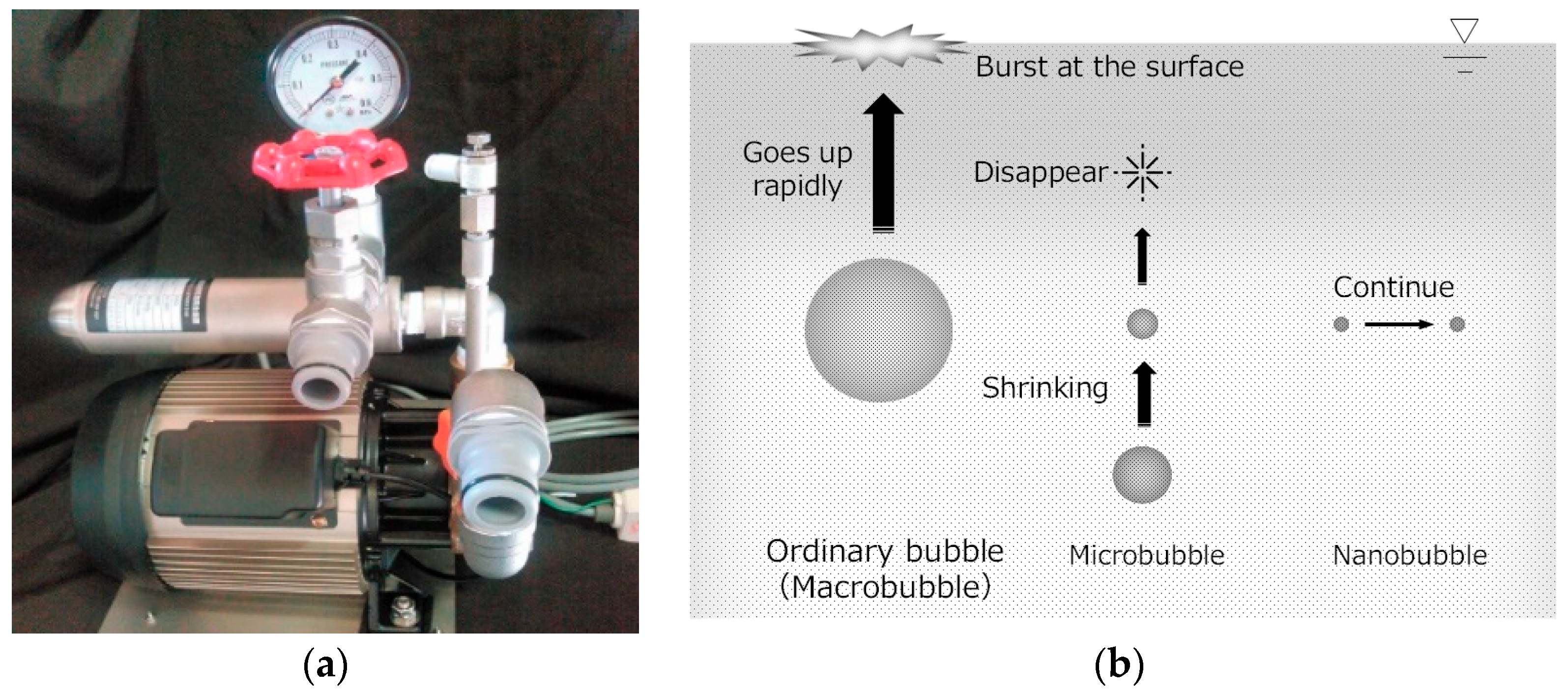
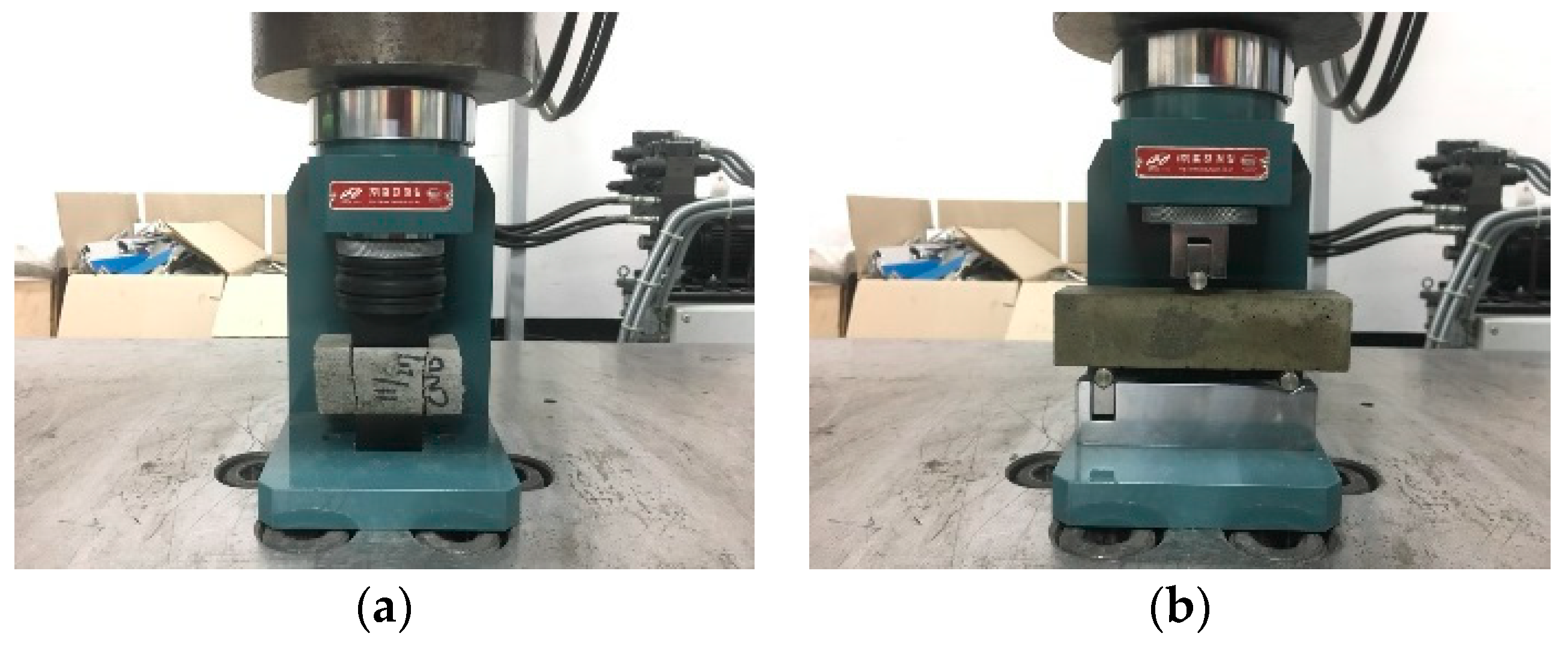

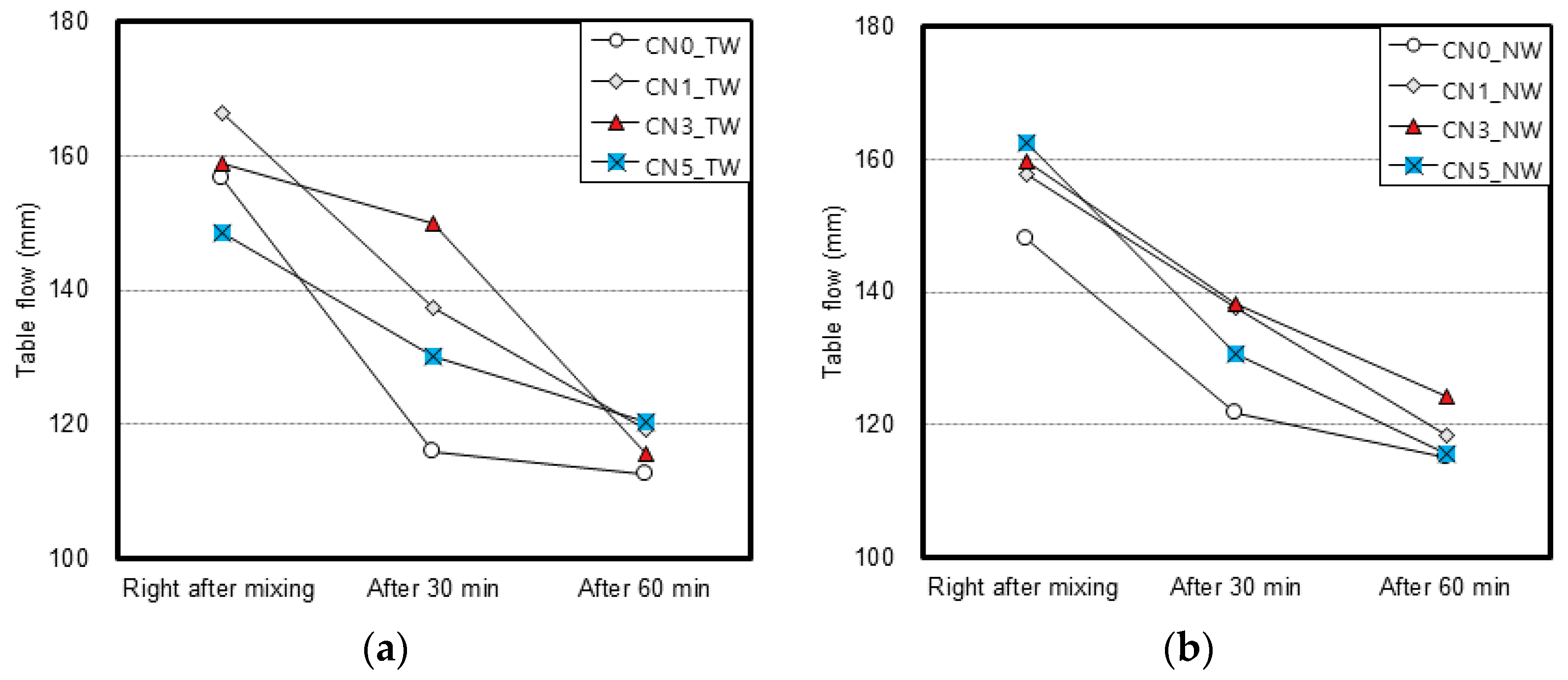
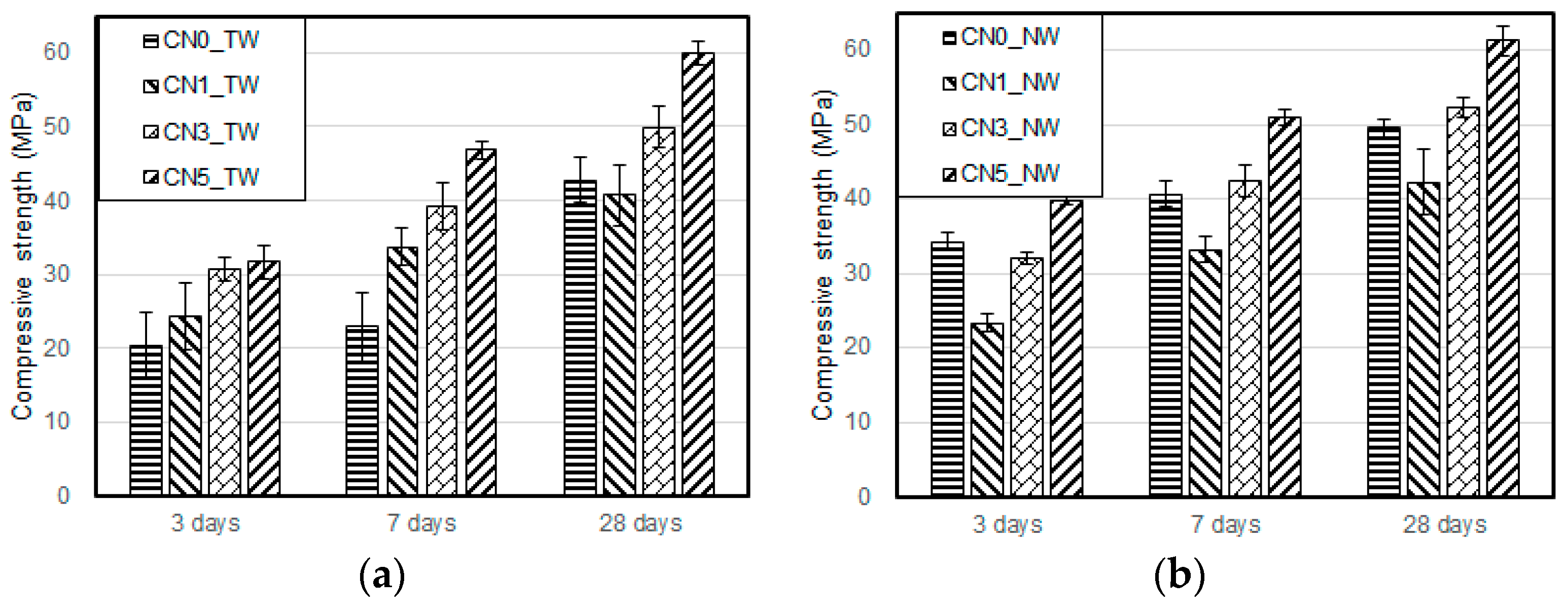
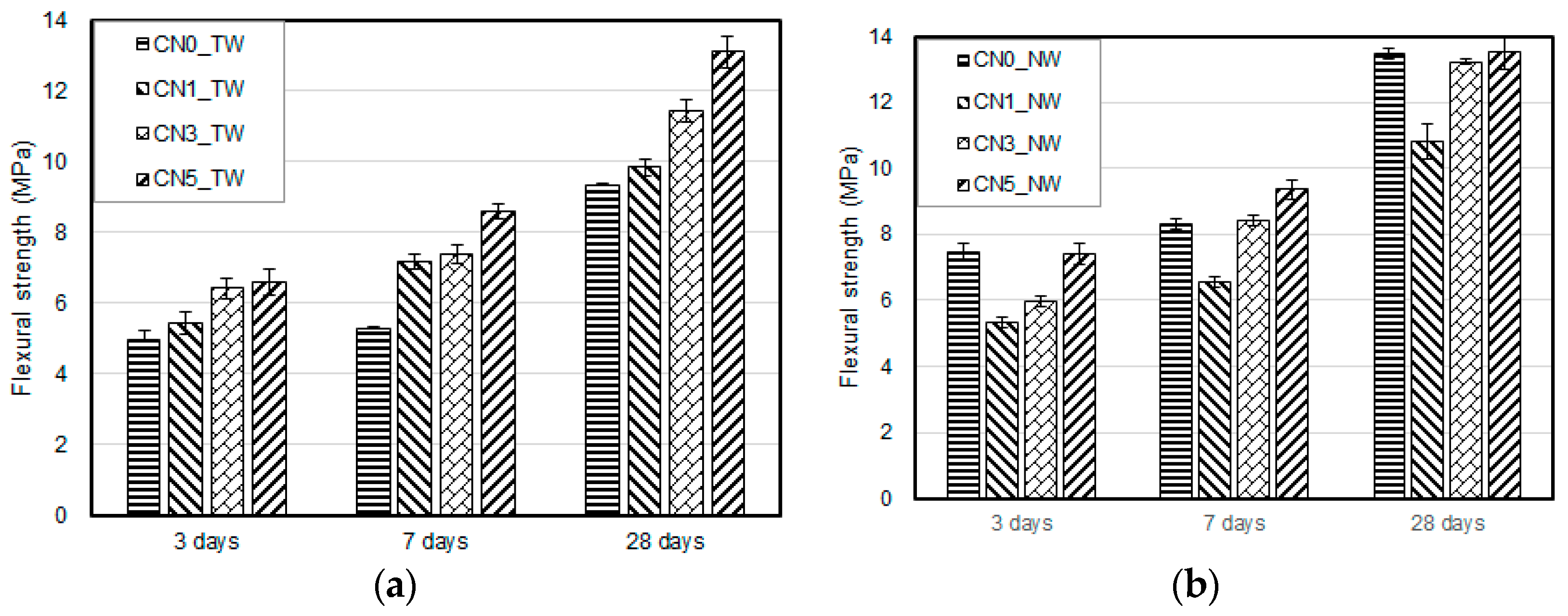
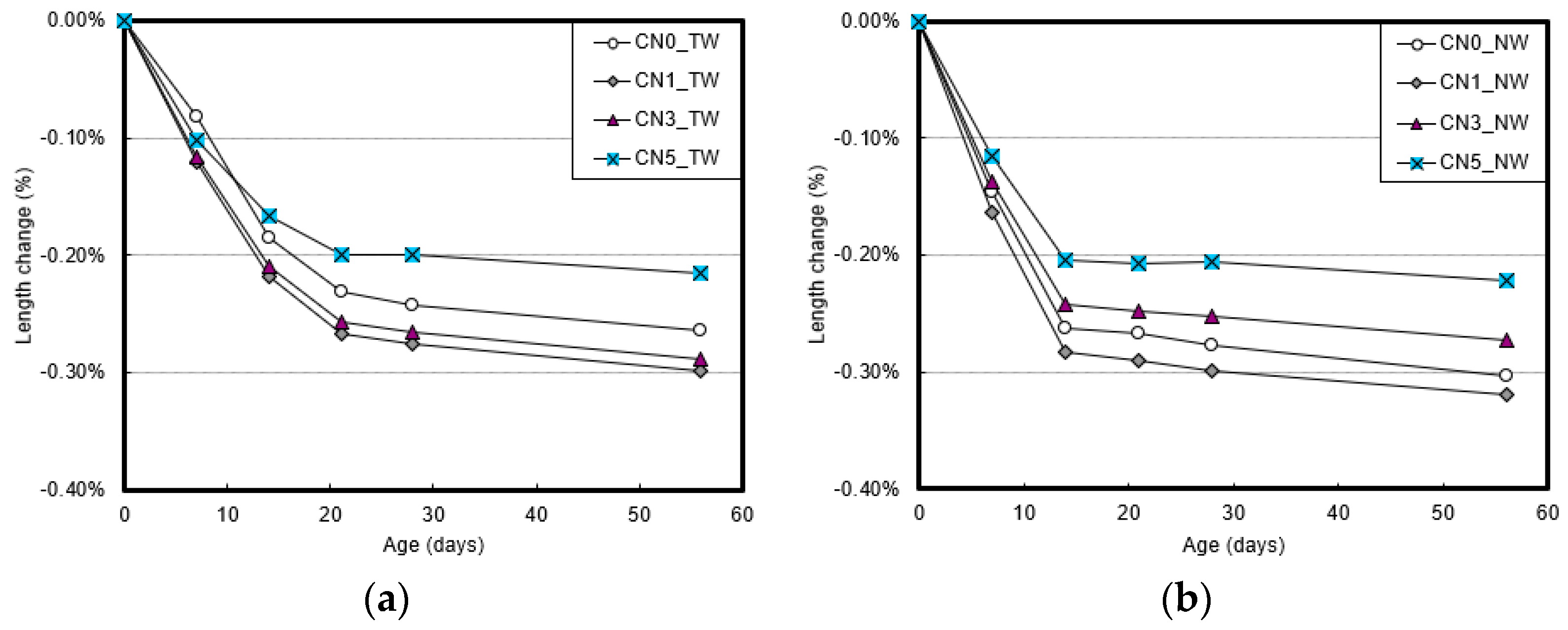
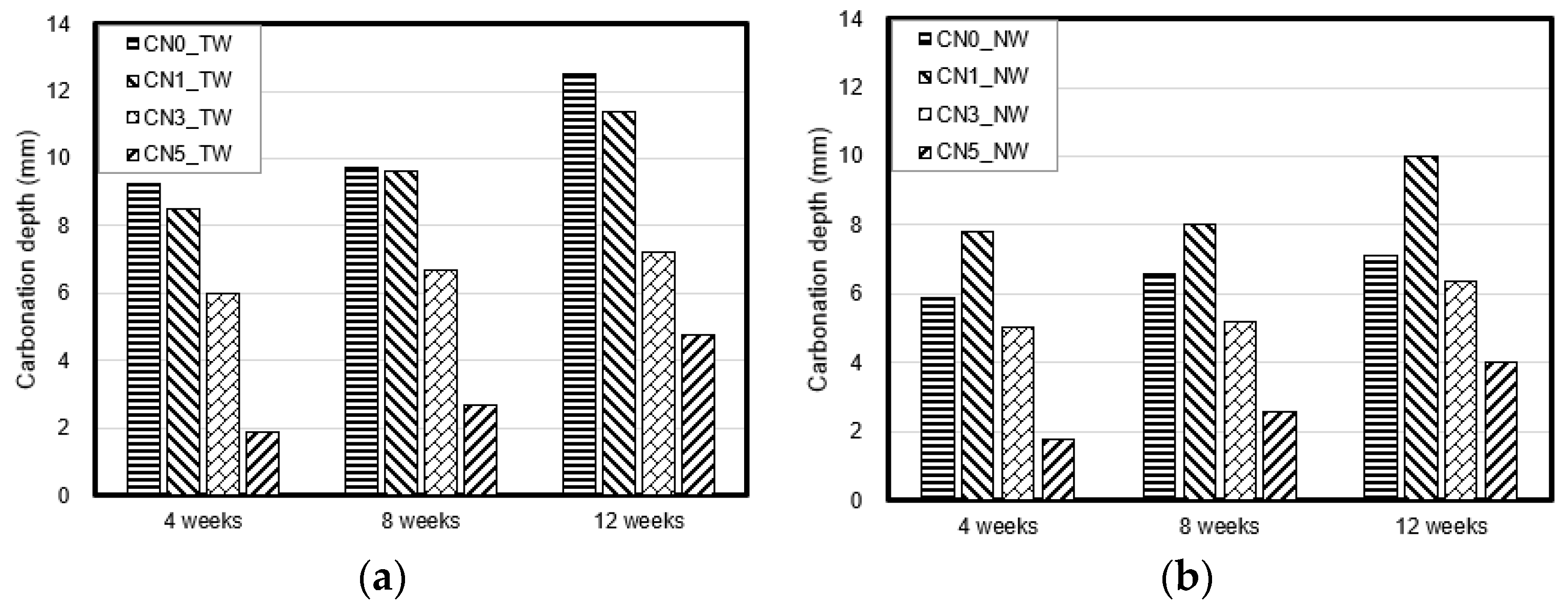
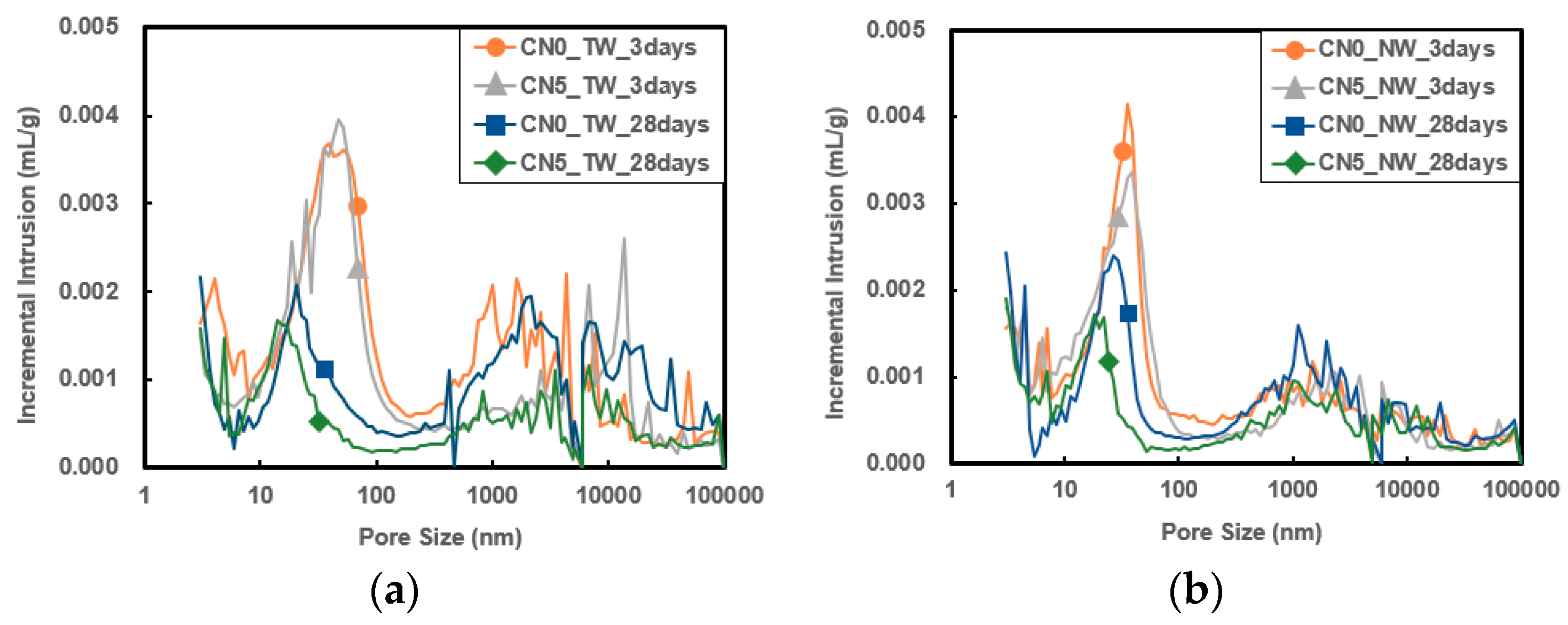
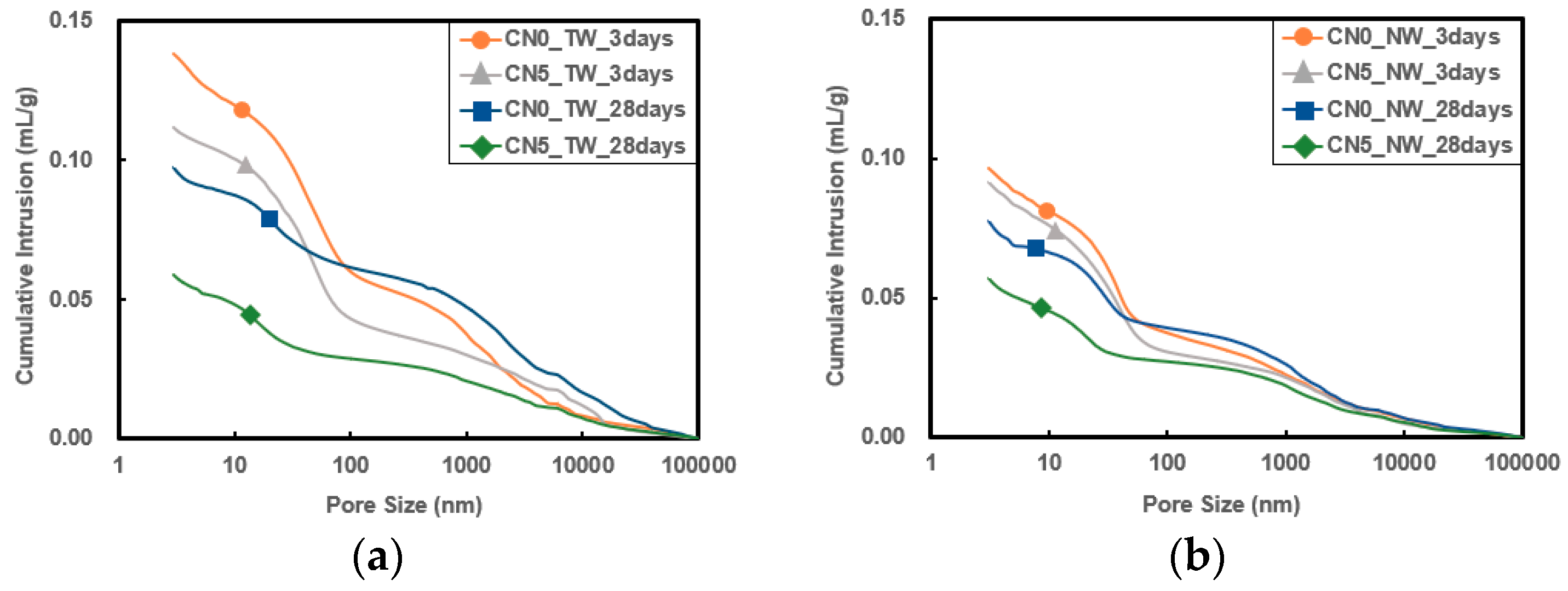

| Item | Values | |
|---|---|---|
| Experimental variables and level | W/M (%) | 16 |
| Ca(NO2)2 dosage 1 | CN0 *, CN1, CN3, CN5 * | |
| Mixing water type | Tap water (TW), Nanobubble water (NW) | |
| Evaluation items |
| |
| W/M 1 (%) | B:S 2 | Binder (wt%) | ||||||
|---|---|---|---|---|---|---|---|---|
| Cement | CSA | Resin | Anhydrous Gypsum | PVA Fiber | Superplasticizer | Viscosity Agent | ||
| 16 | 1:1.45 | 89.5 | 6.6 | 1.5 | 1.2 | 0.6 | 0.58 | 0.04 |
| Evaluation Items | Quality Criteria |
|---|---|
| Compressive strength (N/mm2) | More than 6.0 |
| Flexural strength (N/mm2) | More than 20.0 |
| Carbonation depth (mm) | More than 2.0 |
© 2020 by the authors. Licensee MDPI, Basel, Switzerland. This article is an open access article distributed under the terms and conditions of the Creative Commons Attribution (CC BY) license (http://creativecommons.org/licenses/by/4.0/).
Share and Cite
Kim, H.-j.; Choi, H.; Choi, H.; Lee, B.; Lee, D.; Lee, D.-E. Study on Physical Properties of Mortar for Section Restoration Using Calcium Nitrite and CO2 Nano-Bubble Water. Materials 2020, 13, 3897. https://doi.org/10.3390/ma13173897
Kim H-j, Choi H, Choi H, Lee B, Lee D, Lee D-E. Study on Physical Properties of Mortar for Section Restoration Using Calcium Nitrite and CO2 Nano-Bubble Water. Materials. 2020; 13(17):3897. https://doi.org/10.3390/ma13173897
Chicago/Turabian StyleKim, Ho-jin, Hyeonggil Choi, Heesup Choi, Bokyeong Lee, Dongwoo Lee, and Dong-Eun Lee. 2020. "Study on Physical Properties of Mortar for Section Restoration Using Calcium Nitrite and CO2 Nano-Bubble Water" Materials 13, no. 17: 3897. https://doi.org/10.3390/ma13173897







